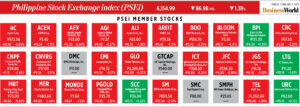Peso weakens on renewed tariff jitters

THE PESO weakened against the dollar on Monday after US President Donald J. Trump said he will introduce new tariffs on all steel and aluminum imports.
The local unit closed at P58.095 per dollar on Monday, weakening by 6.5 centavos from its P58.03 finish on Friday, Bankers Association of the Philippines data showed.
The peso opened Monday’s session weaker at P58.10 against the dollar. It traded lower than its Friday close the entire session, with intraday best at just P58.06, while its worst showing was at P58.175 versus the greenback.
Dollars exchanged went down to $1.197 billion on Monday from $1.28 billion on Friday.
“The dollar-peso closed lower due to soaring risk sentiment after Trump announced his plan to raise 25% tariffs on steel and aluminum,” a trader said by phone.
The pair moved within a narrow range amid market caution ahead of the release of US inflation data and the Bangko Sentral ng Pilipinas’ (BSP) policy meeting this week, the trader added.
January US consumer and producer inflation data will be released on Feb. 12 (Wednesday) and 13 (Thursday), respectively.
Meanwhile, the BSP’s policy-setting Monetary Board will hold its first policy meeting for the year on Thursday.
A BusinessWorld poll conducted last week showed that 19 out of 20 analysts expect the BSP to reduce the target reverse repurchase rate by 25 basis points (bps) at this week’s meeting.
If realized, this would mark the Monetary Board’s fourth straight 25-bp cut since August and would bring the policy rate to 5.5% from 5.75% currently.
Cautious signals from US Federal Reserve officials also supported the dollar, Rizal Commercial Banking Corp. Chief Economist Michael L. Ricafort said in a Viber message.
For Tuesday, the trader expects the peso to move between P57.80 and P58.20 per dollar, while Mr. Ricafort sees it ranging from P58 to P58.20.
Federal Reserve officials on Friday said the US job market is solid and noted the lack of clarity over how Mr. Trump’s policies will affect economic growth and still-elevated inflation, underscoring their no-rush approach to interest rate cuts, Reuters reported.
On Friday the Labor department reported a 4% unemployment rate last month and the addition of 143,000 jobs, a picture “consistent with a healthy labor market that is neither weakening nor showing signs of overheating,” Federal Reserve Governor Adriana Kugler said in Miami, Florida.
At the same time, she said, there is “considerable uncertainty” about the economic impact of new policy proposals, and “recent progress on inflation has been slow and uneven, and inflation remains elevated.”
US inflation by the Fed’s targeted measure, the 12-month change in the personal consumption expenditures price index, ticked up toward the end of last year, measuring 2.6% in December. The Fed’s target is 2%.
“The prudent step is to hold the federal funds rate where it is for some time, given that combination of factors,” Ms. Kugler said.
“We don’t need to be in a hurry” is how Fed Chair Jerome H. Powell characterized the rate-path outlook last month after the US central bank opted to hold short-term US borrowing costs steady in the 4.25%-4.5% range.
Mr. Powell may provide fresh commentary on his economic and rate-path expectations when he gives the first of his twice-yearly monetary policy reports to Congress this week.
Policy uncertainty puts the Fed in “wait and see” mode, Minneapolis Federal Reserve Bank President Neel Kashkari told Yahoo Finance on Friday. The next two months of inflation data will be paramount in shaping Fed policy, Mr. Kashkari said. — Aaron Michael C. Sy with Reuters




